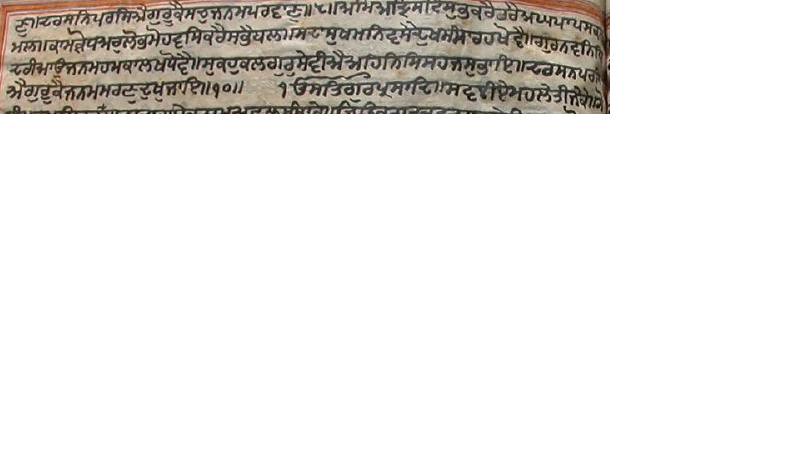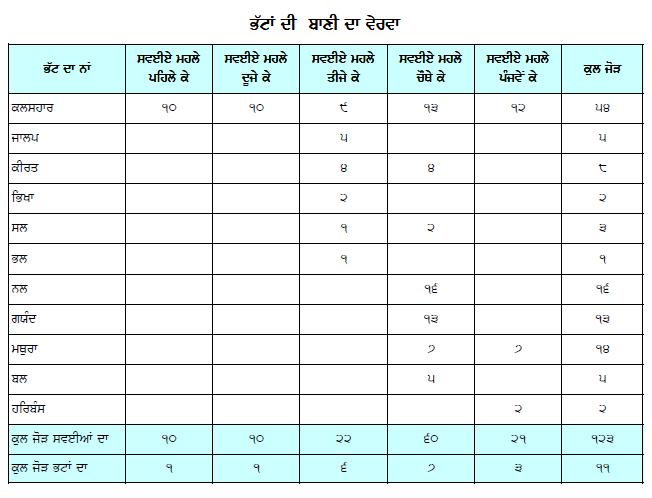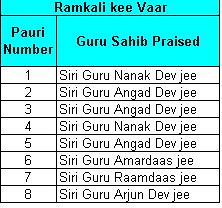 ਸਤਿਗੁਰਬਚਨਕਮਾਵਣੇਸਚਾਏਹੁਵੀਚਾਰੁ॥
ਸਤਿਗੁਰਬਚਨਕਮਾਵਣੇਸਚਾਏਹੁਵੀਚਾਰੁ॥

 ਸਤਿਗੁਰਬਚਨਕਮਾਵਣੇਸਚਾਏਹੁਵੀਚਾਰੁ॥
ਸਤਿਗੁਰਬਚਨਕਮਾਵਣੇਸਚਾਏਹੁਵੀਚਾਰੁ॥

|
ਸੁ ਕਹੁ ਟਲ/ਕਲ ਗੁਰੁ ਸੇਵੀਐ ਅਹਿਨਿਸਿ ਸਹਜਿ ਸੁਭਾਇ ॥ August 02, 2010 12:25AM |
|
Re: ਸੁ ਕਹੁ ਟਲ/ਕਲ ਗੁਰੁ ਸੇਵੀਐ ਅਹਿਨਿਸਿ ਸਹਜਿ ਸੁਭਾਇ ॥ August 02, 2010 06:25AM |


|
Re: ਸੁ ਕਹੁ ਟਲ/ਕਲ ਗੁਰੁ ਸੇਵੀਐ ਅਹਿਨਿਸਿ ਸਹਜਿ ਸੁਭਾਇ ॥ August 02, 2010 08:47AM |
|
Re: ਸੁ ਕਹੁ ਟਲ/ਕਲ ਗੁਰੁ ਸੇਵੀਐ ਅਹਿਨਿਸਿ ਸਹਜਿ ਸੁਭਾਇ ॥ August 02, 2010 12:23PM |
|
Re: ਸੁ ਕਹੁ ਟਲ/ਕਲ ਗੁਰੁ ਸੇਵੀਐ ਅਹਿਨਿਸਿ ਸਹਜਿ ਸੁਭਾਇ ॥ August 02, 2010 12:43PM |
Quote
Presented below are two pictures of Saroops completed in 1714AD and 1837AD respectively.
|
Re: ਸੁ ਕਹੁ ਟਲ/ਕਲ ਗੁਰੁ ਸੇਵੀਐ ਅਹਿਨਿਸਿ ਸਹਜਿ ਸੁਭਾਇ ॥ August 02, 2010 02:56PM |
Quote
Kulbir Singh Ji, what is the evidence that Bhatt Tall did not exist? Do you agree with Prof. Sahib Singh regarding numbering of Bhatts to be 11 instead of 17?

|
Re: ਸੁ ਕਹੁ ਟਲ/ਕਲ ਗੁਰੁ ਸੇਵੀਐ ਅਹਿਨਿਸਿ ਸਹਜਿ ਸੁਭਾਇ ॥ August 02, 2010 04:01PM |
|
Re: ਸੁ ਕਹੁ ਟਲ/ਕਲ ਗੁਰੁ ਸੇਵੀਐ ਅਹਿਨਿਸਿ ਸਹਜਿ ਸੁਭਾਇ ॥ August 02, 2010 04:28PM |
|
Re: ਸੁ ਕਹੁ ਟਲ/ਕਲ ਗੁਰੁ ਸੇਵੀਐ ਅਹਿਨਿਸਿ ਸਹਜਿ ਸੁਭਾਇ ॥ August 03, 2010 12:55AM |
|
Re: ਸੁ ਕਹੁ ਟਲ/ਕਲ ਗੁਰੁ ਸੇਵੀਐ ਅਹਿਨਿਸਿ ਸਹਜਿ ਸੁਭਾਇ ॥ August 03, 2010 01:49AM |
|
Re: ਸੁ ਕਹੁ ਟਲ/ਕਲ ਗੁਰੁ ਸੇਵੀਐ ਅਹਿਨਿਸਿ ਸਹਜਿ ਸੁਭਾਇ ॥ August 03, 2010 09:03AM |
Quote
Kulbir Singh Ji, you misunderstood my question. I asked for evidence that proves that Bhatt Tall did not exist not whether bani under his name does not appear in Guru Granth Sahib.
Quote
Prof. Sahib Singh’s logics sometimes are outlandish. Just because ‘Daas’ means servant doesn’t mean Daas Bhatt did not exist. Daas Bhatt was son of Tokha.
Quote
Kall was son of Bhikha while Kallsahaar was son of Chokha. They were two people but Prof. Sahib Singh and Teja Singh made them one without any evidence. It is similar to saying Bhagat Kabir Ji’s wife was not Loyee because the word means ‘world’.
|
Re: ਸੁ ਕਹੁ ਟਲ/ਕਲ ਗੁਰੁ ਸੇਵੀਐ ਅਹਿਨਿਸਿ ਸਹਜਿ ਸੁਭਾਇ ॥ August 03, 2010 09:10AM |
Quote
ਰਡ - Ang 1399
ਝੋਲਨਾ - Ang 1400
ਸੋਰਠੇ - Ang 1408
This assumption that they are different Bhatts was based on the reasoning that the numbering starts from 1 for each of them. But they do not figure in your chart. Could you please explain whether the above are Bhatt names or do they mean something else. Also, if they are not different Bhatts, why does the numbering system start afresh (from 1) for each of them?
|
Re: ਸੁ ਕਹੁ ਟਲ/ਕਲ ਗੁਰੁ ਸੇਵੀਐ ਅਹਿਨਿਸਿ ਸਹਜਿ ਸੁਭਾਇ ॥ August 03, 2010 09:17AM |
Quote
Bhai Kulbir Singh Jee
Also, just out of curiosity, I would like to ask a question which is not related to this topic.
Does the Saroop, written by Bhai Hardaas the Hazoori Likhaari of Siri Guru Gobind Singh jee, contain ragmala or not?
Also, currently where is this Saroop prakash?
|
Re: ਸੁ ਕਹੁ ਟਲ/ਕਲ ਗੁਰੁ ਸੇਵੀਐ ਅਹਿਨਿਸਿ ਸਹਜਿ ਸੁਭਾਇ ॥ August 03, 2010 10:28AM |
|
Re: ਸੁ ਕਹੁ ਟਲ/ਕਲ ਗੁਰੁ ਸੇਵੀਐ ਅਹਿਨਿਸਿ ਸਹਜਿ ਸੁਭਾਇ ॥ August 03, 2010 10:30AM |
|
Re: ਸੁ ਕਹੁ ਟਲ/ਕਲ ਗੁਰੁ ਸੇਵੀਐ ਅਹਿਨਿਸਿ ਸਹਜਿ ਸੁਭਾਇ ॥ August 03, 2010 11:20AM |
|
Re: ਸੁ ਕਹੁ ਟਲ/ਕਲ ਗੁਰੁ ਸੇਵੀਐ ਅਹਿਨਿਸਿ ਸਹਜਿ ਸੁਭਾਇ ॥ August 03, 2010 11:56AM |
Quote
Kulbir Singh Ji, thanks for your reply and detailed explanation. I have few additional questions. Bhatt Swayeas are ustat of Guru Sahib. Vaar of Satta and Balwand is also ustat of Guru Sahib. In both, organization is not based on writers but chronology of Gurus. In Vaar if first 3 pauris are of Balwand and next three are of Satta then numbering at the end of pauri 4 should be ॥1॥4॥ but the numbering system does not tell which pauri belongs to whom.

Quote
I am not saying Prof. Sahib Singh was not a great scholar but it is a known fact that he sometimes using discursive logic rejected our most popular and known traditions and sakhis.
|
Re: ਸੁ ਕਹੁ ਟਲ/ਕਲ ਗੁਰੁ ਸੇਵੀਐ ਅਹਿਨਿਸਿ ਸਹਜਿ ਸੁਭਾਇ ॥ August 03, 2010 12:02PM |
Quote
For so many years, I was listening and saying ਸੁ ਕਹੁ ਟਲ ਗੁਰੁ ਸੇਵੀਐ ਅਹਿਨਿਸਿ ਸਹਜਿ ਸੁਭਾਇ ॥ It will be interesting and difficult to change now. May be I will avoid reading it, at all, in Sangat. How do you do it?
|
Re: ਸੁ ਕਹੁ ਟਲ/ਕਲ ਗੁਰੁ ਸੇਵੀਐ ਅਹਿਨਿਸਿ ਸਹਜਿ ਸੁਭਾਇ ॥ August 03, 2010 12:15PM |
|
Re: ਸੁ ਕਹੁ ਟਲ/ਕਲ ਗੁਰੁ ਸੇਵੀਐ ਅਹਿਨਿਸਿ ਸਹਜਿ ਸੁਭਾਇ ॥ August 03, 2010 12:49PM |
|
Re: ਸੁ ਕਹੁ ਟਲ/ਕਲ ਗੁਰੁ ਸੇਵੀਐ ਅਹਿਨਿਸਿ ਸਹਜਿ ਸੁਭਾਇ ॥ August 03, 2010 01:08PM |
Quote
Do you think Bhatt Swayeas were also written by Guru Sahib and not by Bhatts themselves considering the fact that Bhatts always wrote in Bhthakshri?
|
Re: ਸੁ ਕਹੁ ਟਲ/ਕਲ ਗੁਰੁ ਸੇਵੀਐ ਅਹਿਨਿਸਿ ਸਹਜਿ ਸੁਭਾਇ ॥ August 03, 2010 01:46PM |
|
Re: ਸੁ ਕਹੁ ਟਲ/ਕਲ ਗੁਰੁ ਸੇਵੀਐ ਅਹਿਨਿਸਿ ਸਹਜਿ ਸੁਭਾਇ ॥ July 14, 2011 08:46AM |
|
Re: ਸੁ ਕਹੁ ਟਲ/ਕਲ ਗੁਰੁ ਸੇਵੀਐ ਅਹਿਨਿਸਿ ਸਹਜਿ ਸੁਭਾਇ ॥ July 14, 2011 09:48AM |
|
Re: ਸੁ ਕਹੁ ਟਲ/ਕਲ ਗੁਰੁ ਸੇਵੀਐ ਅਹਿਨਿਸਿ ਸਹਜਿ ਸੁਭਾਇ ॥ July 14, 2011 11:32AM |
|
Re: ਸੁ ਕਹੁ ਟਲ/ਕਲ ਗੁਰੁ ਸੇਵੀਐ ਅਹਿਨਿਸਿ ਸਹਜਿ ਸੁਭਾਇ ॥ July 14, 2011 02:07PM |
Quote
So Kulbir Singh Jeeo what were the reasons /arguments for centuries the word "TAL" referrring to Bhatt Tal , has been used ?
Which scolars are in disagrrement with u on this ? and why?
|
Re: ਸੁ ਕਹੁ ਟਲ/ਕਲ ਗੁਰੁ ਸੇਵੀਐ ਅਹਿਨਿਸਿ ਸਹਜਿ ਸੁਭਾਇ ॥ July 14, 2011 03:08PM |
|
Re: ਸੁ ਕਹੁ ਟਲ/ਕਲ ਗੁਰੁ ਸੇਵੀਐ ਅਹਿਨਿਸਿ ਸਹਜਿ ਸੁਭਾਇ ॥ July 14, 2011 03:51PM |
|
Re: ਸੁ ਕਹੁ ਟਲ/ਕਲ ਗੁਰੁ ਸੇਵੀਐ ਅਹਿਨਿਸਿ ਸਹਜਿ ਸੁਭਾਇ ॥ July 16, 2011 09:24AM |
|
Re: ਸੁ ਕਹੁ ਟਲ/ਕਲ ਗੁਰੁ ਸੇਵੀਐ ਅਹਿਨਿਸਿ ਸਹਜਿ ਸੁਭਾਇ ॥ July 16, 2011 12:50PM |